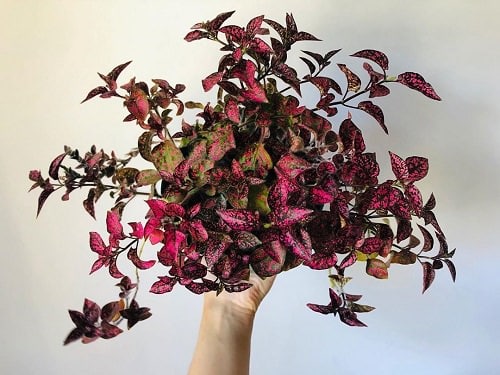Freckle Face Plant offers unique foliage that looks great on both home and gardens. Read on to Know everything about Polka Dot Plant Care!

This little specimen looks beautiful with its spotted leaves and can grow easily as long as you know about the right Polka Dot Plant Care. Let’s have a look!
Botanical Name: Hypoestes phyllostachya
Common Name: Flamingo-plant, Freckle Face, Splash Plant, Measles plant
Check out Eye-Catching Polka Dot Print Houseplants here
About Polka Dot Plants
Hypoestes phyllostachya or the Polka Dot plant belongs to the Acanthaceae family. A part of its name signifies a leaf spike, which refers to the sharp edges of the oval-shaped leaves in Latin.
There are more than 100 types of Polka Dot plants, all with various shades of colors and patterns. The most popular one is the Pink Polka Dot because of its striking pattern of pink splashes on green leaves that gives it an impression of being spray-painted.
Best Varieties of Polka Dot Plants

There are over 100 varieties within the main species, Hypoestes phyllostachya; all are cross-bred for their leaf coloration.
- ‘Confetti’: Has green leaves and spots of white, rose, pink, burgundy, or red
- ‘Splash’ series: The green leaves have splashes of pinks, whites, or reds
- ‘Camina’: Dark green leaves with red-freckles
- ‘Pink Brocade’: Glossy green leaves with pink spots
Have a look at the different types of Polka Dot plant varieties here
Propagating Polka Dot Plants
Two of the most common ways to grow polka dot plants are seeds and cuttings. To save time and ensure positive propagation, always go for the ‘cuttings’ method.
- Take 4-6 inches of cutting from a healthy plant, right below the node.
- Remove all the leaves from the bottom, dip the end in honey or a rooting hormone, and plant in a quality potting medium or seed starting mix.
- Using a spray bottle, water the cutting well and keep the pot where it can get bright, indirect light.
- You also have an option to propagate the cuttings in water – put the cutting in a jar filled with water. Change the water every 4-5 days and keep it where the cutting gets bright indirect light. When the cutting forms roots, you can transplant it to a pot.
Requirements for Growing Polka Dot Plant

Location
Pick the location for the plant wisely as too much light can fade the brilliant spots on the leaves, and too much shade can make the plant lose its vigor. While growing it indoors, keeping it near an east or south-facing window will do the trick. Do make sure that the plant is not exposed to the harsh afternoon sun for a long duration.
Soil
Polka dot plant likes well-draining soil, rich in organic nutrients just like most other houseplants. You can go for good quality, all-purpose potting mix for it. If you are using garden soil, do not forget to add some pumice or perlite to improve the drainage.
Watering
For the best growth and color, you will have to keep the soil on the slightly moist side. However, avoid overwatering the plant. Never let the soil dry out completely as it will cause the plant to wilt and die.
The best method to follow is to keep an eye on the topsoil, checking it with your finger once every 2-3 days. If it feels slightly dry to touch, then it’s time to water the plant. Also, reduce the watering rate in winters.
Temperature
This colorful plant grows best in the temperature range of 60-80 F or 15-26 C.
Humidity
Polka dot plant prefers humid conditions. Mist the leaves or place the container over a tray filled with pebbles and water. You can also get a humidifier.
Pot Size
Go for any medium-sized pot, that’s about 6-8 inches wide and deep. Make sure it has a drainage hole at the bottom. The plant also looks amazing in window boxes.
Polka Dot Plant Care

Fertilizer
The plant is a heavy feeder and you will have to keep a close eye on the feeding schedule to ensure it thrives well. Use a balanced, liquid fertilizer, once in 4-5 weeks during its growing period. Do refer to the label for dosage.
Pruning
Prune dead stems and leaves from time to time to keep the plant looking tidy and fresh. It will also help you to maintain its bushy and compact appearance.
During summer, the plant blooms insignificant lilac flowers on spikes. Consider pinching them to help the plant’s energy stay focused on growing its stunning foliage.
Pests and Diseases
Be careful about mealybugs, aphids, whiteflies, and scales. You can handpick them or use neem oil or insecticidal soap solution to get rid of them.
Polka Dot Plant Benefits
The most beneficial aspect of the Polka Dot plant is that it helps purify the indoor air while looking beautiful! It is also completely non-poisonous and poses no harm to children or pets.



Awesome !! Polka dot Plants are the prettiest, thanks for sharing this information